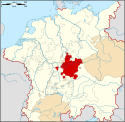- County of Rieneck
-
Bailiwick of the Archbishopric of Mainz;
Lordship (County) of Rieneck
Vogtei des Mainzer Erzstift;
Herrschaft (Grafschaft) RieneckState of the Holy Roman Empire ← 
←
before 1100 – 1408
1673 – 1806 →
→
 →
→Coat of arms
Capital Lohr Government Principality Historical era Middle Ages - First mention
of Rieneck
ca 790- County established before 1100 11th century - Court of city rights by
Emperor Louis IV
1333- Comital line
extinct
1408- Purchased by
County of Nostitz
1673- Mediatised to
Aschaffenburg
1806 1806- Granted to Bavaria 1815 The County of Rieneck was a comital domain within the Holy Roman Empire that lay in what is now northwestern Bavaria (in the west of Lower Franconia). It bore the same name as its original ruling family, the Counts of Rieneck, from whom the county and its main seat, the town of Rieneck, got their names.
History
The first documentary evidence of what is now the town of Rieneck surfaces in AD 790.[1] Rieneck gained its name from the Counts of Rieneck, who founded the line of Burgraves of Gerhart[2] at the end of the 11th century from the Vogtei over the Archbishopric of Mainz between Neustadt am Main, Lohr am Main and Karlstadt am Main.[3] The family line died out with Gerhard I in 1108. His only daughter married Arnold, Count of Loon (1101–39), inheriting Rienecker territory and, around 1156/7 by Ludwig I, Count of Loon, the family name,[4] possibly as a result of an unsuccessful claim to the Rhineland castle Burg Rhieneck.[3] As soon as the name was acquired, his family built the castle on the banks of the river Sinn.[3] With the 1168 expansion of the castle, Ludwig I chose Burg Rieneck as his court.[3]
From 1295, Lohr am Main became the seat of the burgraviate and border posts were set up to shelter the local castle from the domains of the archbishopric.[3] In 1333, the county was granted city rights by Louis IV the Bavarian, Holy Roman Emperor, as thanks for support during his struggle for the kingdom.[3] Skillful dynastic marriages allowed for the gradual expansion of their domain; conflict often resulted between Rieneck and their neighbours, the Archbishopric of Mainz and the Bishopric of Würzburg.[3]
When, in 1333, the male comital line died out, the Bishopric of Würzburg tried to acquire the Lordship. After the 1366 death of Johann von Rienecks, the Archbishopric of Mainz claimed feudal sovereignty over the whole county, a claim reaffirmed after the 1408 death of Count Louis XI.[3]
In 1544, the Protestant Reformation was introduced to the county by the Schaffhauser Johann Konrad Ulmer. The comital line died out again with Philip III on 3 September 1559, reigniting the feud over the succession between the sees of Mainz and Würzburg; Lohr became the administrative seat of the Lordship of Rieneck under the Archbishop-Elector of Mainz.[3]
In 1673, the county was purchased by Johann Hartwig, Count of Nostitz.[3][4] The Great French War and the Napoleonic abolition of the Empire led to the county being mediatised to the Principality of Aschaffenburg in 1806. In 1815, the county — then a part of the Grand Duchy of Frankfurt — was granted to the Kingdom of Bavaria.[3]
-
Coat of arms of the Counts of Rieneck, from the Scheiblersches Wappenbuch
References
- ^ (German) Rieneck, German Wikipedia as of 26 August 2008
- ^ (German) Rieneck (Adelsgeschlecht), German Wikipedia as of 26 August 2008
- ^ a b c d e f g h i j k (German) Grafen von RieneckPDF
- ^ a b (German) Grafschaft Rieneck from Thomas Höckmann's Historical Atlas of Germany
 Franconian Circle (1500–1806) of the
Franconian Circle (1500–1806) of the  Holy Roman Empire
Holy Roman EmpireEcclesiastical 
Secular Ansbach · Bayreuth · Henneberg (Römhild, Schleusingen) · Hohenlohe-Waldenburg · Löwenstein-Wertheim · SchwarzenbergCounts / Lords Cities Categories:- Former principalities
- Former countries in Europe
- States of the Holy Roman Empire
- States and territories established in the 11th century
- States and territories disestablished in 1806
- 1408 disestablishments
- States and territories established in 1673
- 1806 disestablishments
- Main-Spessart
- Franconian Circle
-
Wikimedia Foundation. 2010.


